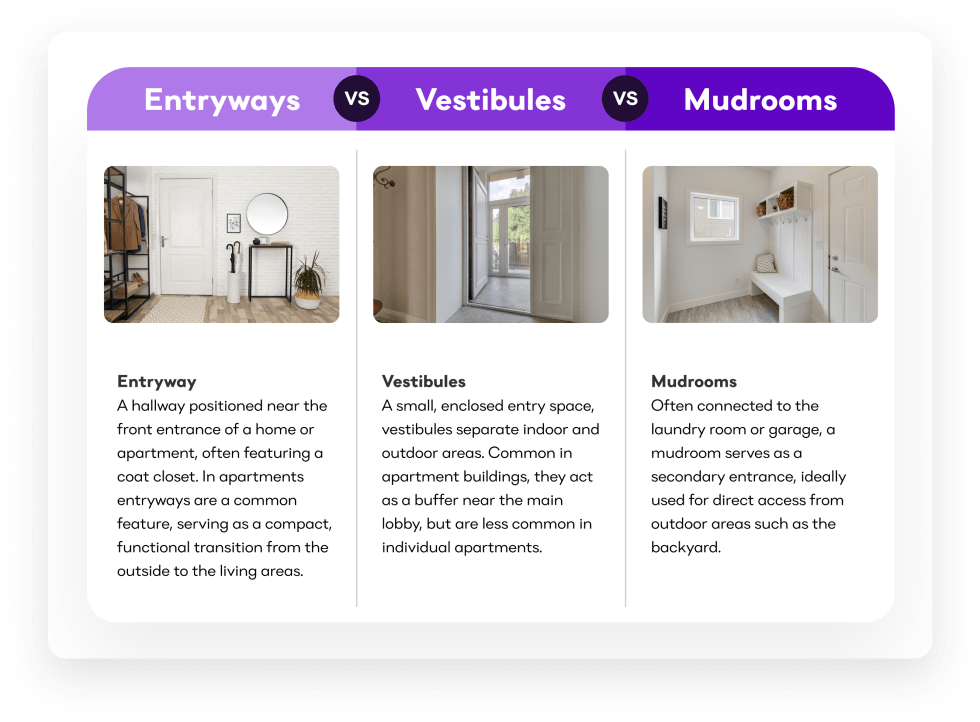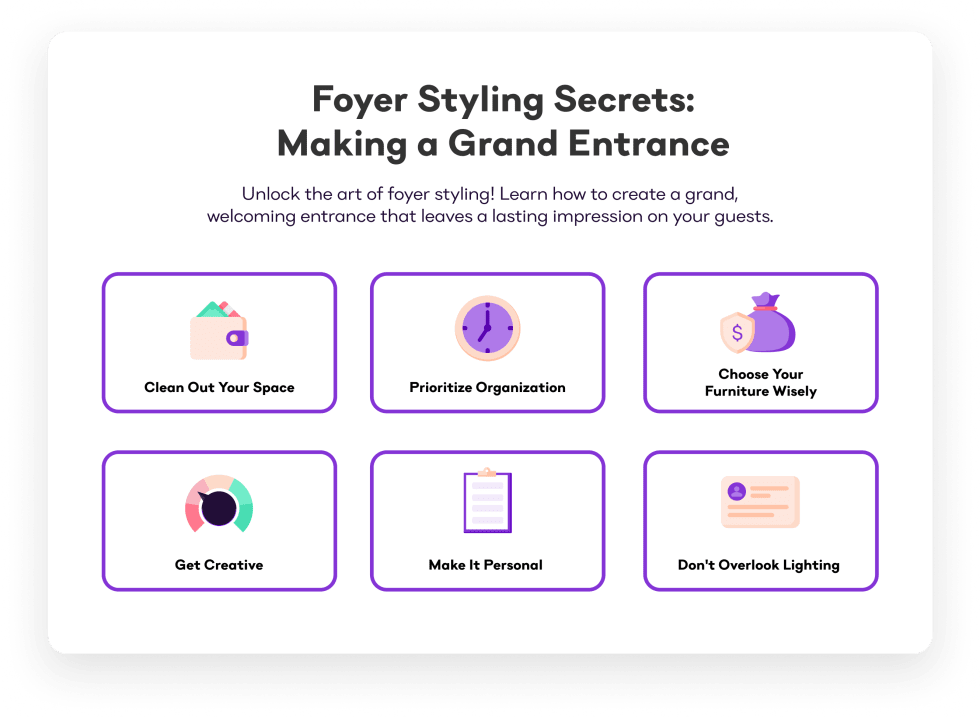South Bank at Quarry Trails
- 91 units available
- Studio • 1 bed • 2 bed • 3 bed
- Amenities
In unit laundry, Patio / balcony, Granite counters, Pet friendly, Stainless steel, Walk in closets + more

Ah, the foyer. Anything with a silent "r" at the end is always going to sound fancy! But is it really a luxury amenity? And how do you know if you have one (or need one)?
Find out in our helpful guide. And if you do have a foyer, read on to find our top six styling tips!
A foyer (aka an "anteroom") is a space that connects your front door to the rest of your house. It may have a variety of uses, but generally provides a transition point between the outside world and your home.
Foyers act as transition points in several ways, often by allowing you to store coats and hats as you enter or by providing a small table for things like letters and keys. A foyer is generally large enough to move around in and often contains a small closet, umbrella or coat rack, or piece of furniture.
Many people use the term foyer interchangeably with "vestibule" and "entryway." They're similar spaces that serve as the first area in your home or apartment but come with some key differences.

A foyer is a space that is usually located next to your front door, connecting other rooms. Many people use the term foyer interchangeably with "vestibule" and "entryway." They're similar spaces that serve as the first area in your home or apartment but come with some key differences.
Entryway - A hallway located off the front of an apartment or home that typically offers a coat closet. Entryways are more common in apartments due to the smaller overall space.
Vestibule - An enclosed entry area that divides the indoors from the outdoors. Vestibules aren't usually found in apartments, though you may find them situated off of the lobby of a building.
Mudroom- Usually serves as a secondary entrance attached to the laundry area or garage. It’s designed to quickly enter from the outdoors, usually from a backyard.

It’s possible for apartments to have foyers, though they're usually smaller spaces than what you would find in a house. It may just be a space to greet guests and take their coats to put in a hall closet. Sometimes apartments have entryways that double as hallways leading into the main living room or another area.
Foyers can encompass an entire room and typically have a bench or chair to sit. Because foyers are larger than an entryway with more space, it's common to find a table or shelf, a carpet runner, and a mirror to add some style and personality. In apartments, people typically use the foyer to remove their shoes and place coats on a coat rack.
As the name implies, a mudroom is where you can store anything muddy or dirty from the outdoors. Dirty boots, coats, and umbrellas are usually tucked away in a mudroom. However, you can also just use a mudroom as a coat and shoe area despite the weather.
Like a foyer, an entryway is a space to remove your shoes, hang your keys, and put away your jacket. It's also usually the first impression of your apartment while greeting guests and offers a touch of decor or personalization.
While you typically won’t find a vestibule inside an apartment or home ,they are helpful to keep rain or frigid air from seeping into the lobby and to the rest of an apartment building.
Foyers, while they may create a grand first impression, do not significantly add to a home's overall market value for several reasons. Firstly, foyers are considered a luxury rather than a necessity. In real estate, factors that significantly impact a home's value typically revolve around functional aspects such as the number of bedrooms, bathrooms, the overall square footage, and the usability of the space. Foyers, being primarily a transitional space, don't contribute to the home's functional living area in the same way these other factors do.
Secondly, the impact of a foyer on a home's value is also influenced by market trends and buyer preferences, which can vary greatly. While some buyers may be charmed by a large, elegant foyer, others may not view a foyer as an effective utilization of space. In contrast to features like updated kitchens or bathrooms, which universally appeal to buyers due to their practical utility, foyers are more about personal taste and style.

Entryways are short on space, but that doesn't mean you need to skimp on style. Here are a few ideas to style an entryway in your apartment.
Before you start buying things for your entryway, assess how much space you have to work with. With limited space, it's essential to make your entryway space functional and keep it from feeling cluttered. Start by pulling everything out from your foyer and putting things into broad piles. It's generally a good idea to start with piles for things to keep, things to donate, things to trash, and things to put away in other rooms.
Once you've narrowed down your items to only the things you use on a regular basis, you can start making decisions about what to add.
Before you start planning out cute furniture ideas, prioritize organizing the things you use everyday. Maximize your entryway's organization by keeping your coats, shoes, mail and anything else that comes into your apartment tidy. If you don't have a closet, a coat rack or hook that hangs over your door is an easy solution. A small table, floating shelves, or decorative bins can also be used to add more storage area to your entryway while enhancing your decor.
Entryways are often small and narrow, allowing for one or two small pieces of furniture. A narrow trunk with inside storage is also a good option for shoe storage or seasonal clothes that you're not currently using.
If there’s not enough room for a bench, try a small ottoman with inside storage that doubles as a sitting area to put on your shoes. Open the lid of your ottoman to tuck away a hat, gloves, or a place to drop your mail or receipts.
Apartment entryways require some creativity, especially if you live in a studio apartment or efficiency apartment. You can create a DIY entryway by using a colorful rug to designate the space as a greeting area. The same idea goes for painting. Check your lease or ask your landlord if you can paint your entryway a different color to make it stand out from the rest of your space.
If you live in a loft apartment, you likely have a large, undefined space. You can still design your own entry area with the help of room dividers or tall, potted plants. Situate them to create the feeling of an entryway or turn into a makeshift foyer that includes a small sitting area for your guests.
The entryway should make a positive first impression when friends and family come over. Give them a peek into your personal life with a phots, art, and anything else that says something about your life. Wall photos and artwork don’t take up much room and are ideal for small spaces that need a colorful refresh.
Interested in learning more about the basics of foyer styling so you can add your own touch? Check out this one minute guide from Livspace:
Coming home to a dark apartment with poor lighting is the least welcoming. If you already have an overhead light, consider swapping out the bulb to a softer option that feels more inviting.
A chandelier or quirky lighting fixture can set the tone and style for your apartment. If you're short on overhead lighting options and don’t have room for a proper lamp, battery-powered touch lights are easy to turn off and on as you leave your apartment and won't take up much space.
Looking for a new place, perhaps with a grander entrance? Take our easy quiz to get matched with your next home today!



In unit laundry, Patio / balcony, Granite counters, Pet friendly, Stainless steel, Walk in closets + more
In unit laundry, Hardwood floors, Dishwasher, 24hr maintenance, Stainless steel, Walk in closets + more